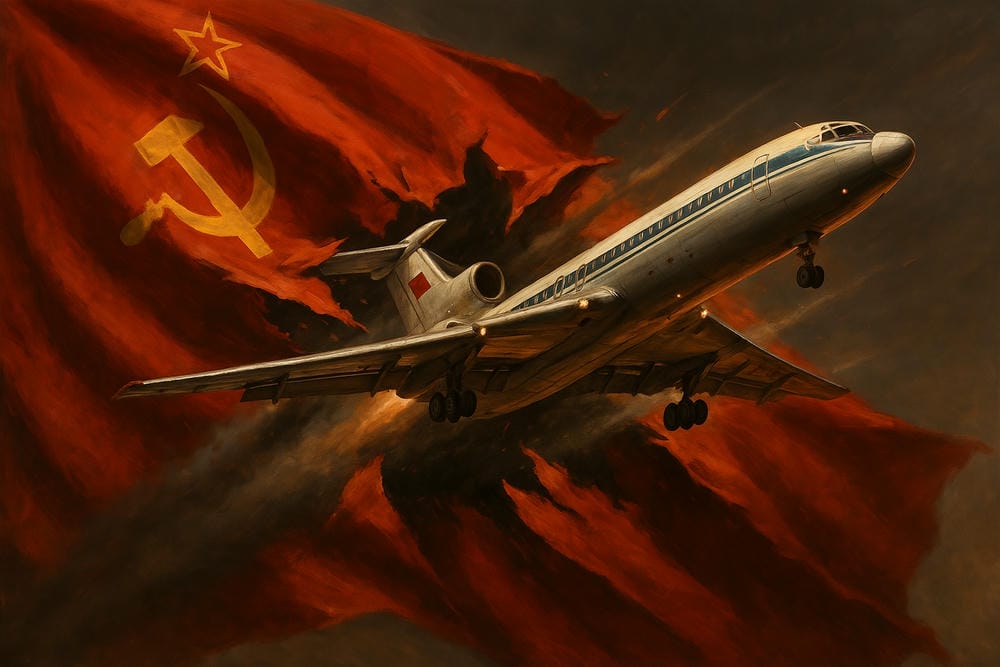The Art of Russian Folk Dance and Music presents a fascinating study of cultural resilience and creativity, tracing its origins to ancient Slavic traditions and evolving through significant historical periods like the Mongol invasion and the Tsarist era. Characterized by dynamic choreography, vibrant costumes, and the distinctive sounds of instruments such as the balalaika and accordion, these performances are more than mere entertainment; they are a living narrative of communal heritage. As contemporary artists blend these age-old elements with modern influences, one might wonder how these traditions continue to resonate in today’s globalized world.
Origins and Historical Background
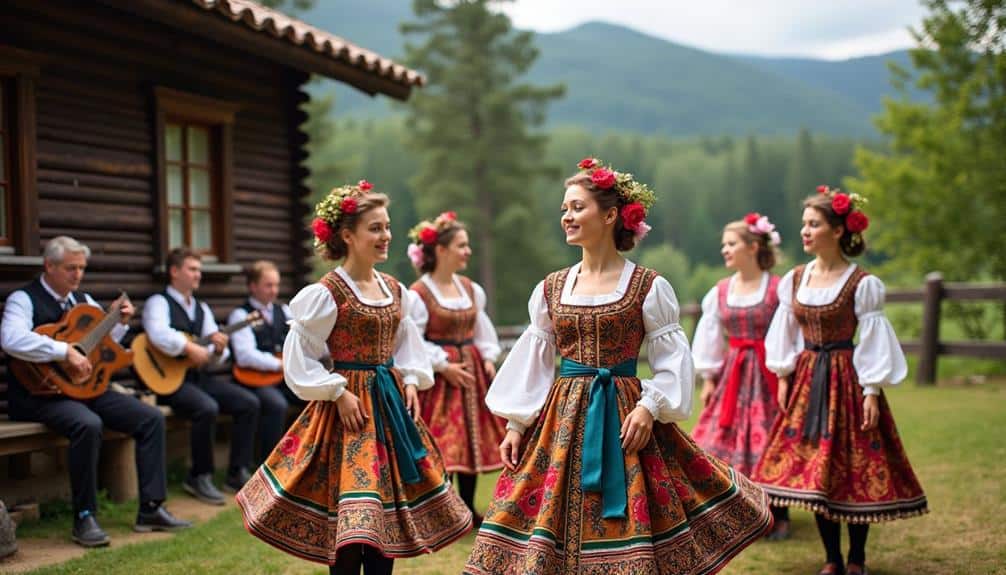
The origins of Russian folk dance and music are deeply rooted in the ancient Slavic traditions that predate the formation of the Russian state. These cultural expressions evolved over centuries, shaped by the diverse influences that swept across the vast Russian territories. Initially, the rituals and celebrations of the early Slavs incorporated music and dance as essential components, serving both spiritual and communal purposes.
Historical evolution played a significant role in the development of Russian folk dance and music. As the Russian state began to form in the 9th century, interactions with neighboring cultures, including the Byzantine Empire and various nomadic tribes, introduced new elements and styles.
The Mongol invasion in the 13th century further diversified these cultural influences, adding layers of complexity to the indigenous traditions.
During the Tsarist era, folk music and dance continued to evolve, reflecting the socio-political changes of the time. The establishment of serfdom and the influence of the Orthodox Church also left their mark on these art forms.
Key Elements of Folk Dance
Key elements of Russian folk dance encompass a variety of distinctive features that reflect the cultural and historical milieu of the Russian people. At the heart of these dances are specific dance techniques characterized by energetic movements and intricate footwork. These techniques often include elements such as jumps, squats, and spins, which are executed with precision and vigor.
The choreography is usually designed to tell a story or depict scenes from everyday life, embodying the spirit and traditions of Russian communities.
Equally significant are the costume styles, which play an essential role in the visual and cultural authenticity of the performances. Traditional Russian folk costumes are vibrant and richly decorated, often featuring elaborate embroidery, intricate patterns, and vivid colors.
These costumes not only enhance the aesthetic appeal but also signify regional identities and historical influences. For men, costumes might include tunics, wide trousers, and high boots, while women’s attire typically consists of ornate dresses, aprons, and headdresses.
The harmonious blend of dynamic dance techniques and traditional costume styles creates an enthralling and immersive experience, allowing audiences to connect deeply with the rich cultural heritage of Russia.
Traditional Russian Instruments
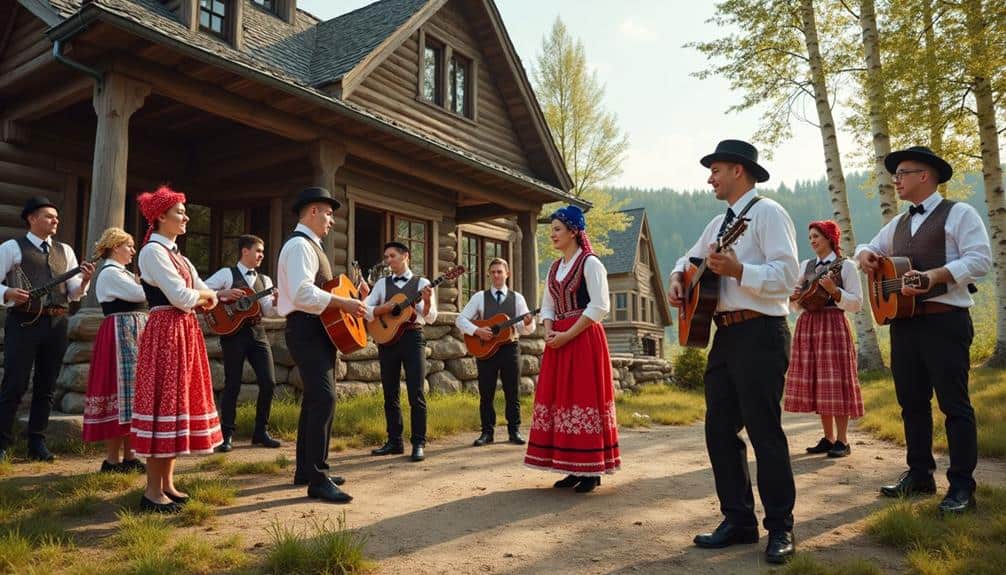
Integral to the enchanting performances of Russian folk dance are the traditional instruments that provide the rhythmic and melodic foundation. Among these, the balalaika stands out as a quintessential symbol of Russian musical craftsmanship. This triangular, three-stringed instrument is often celebrated for its distinctive sound, which ranges from bright and lively to deep and resonant.
The balalaika craftsmanship involves meticulous attention to detail, with artisans carefully selecting woods and shaping the instrument to achieve ideal tonal quality. Each balalaika is not merely an instrument but a work of art, embodying the cultural heritage and musical traditions of Russia.
Equally significant is the accordion, an instrument whose versatility and dynamic range have made it a staple in Russian folk music. Mastering accordion techniques requires a blend of dexterity and musical intuition, as players must skillfully manipulate the bellows while coordinating complex finger patterns on the keys and buttons.
The accordion’s ability to produce both melody and harmony simultaneously allows it to complement the intricate steps of Russian folk dances, creating a rich, immersive auditory experience. Together, these traditional instruments not only enhance the performance but also preserve the rich musical legacy of Russian folk culture.
Famous Folk Dances
Among the myriad of expressive traditions within Russian folk culture, famous folk dances hold a place of high esteem, showcasing the country’s rich heritage through movement and music. One of the most notable is the Cossack Dances, characterized by their vigorous dance movements and acrobatic dance techniques. These dances often reflect the martial prowess and spirited nature of the Cossack warriors.
Dance costumes play a significant role in these performances, with brightly colored attire adorned with intricate embroidery, contributing to the visual appeal and authenticity of the dances. Rooted deeply in rural traditions, many of these dances were originally performed during communal celebrations and seasonal festivities, preserving the cultural ethos of Russian villages.
Traditional choreography in Russian folk dances is meticulously passed down through generations, ensuring the preservation of historical dance techniques. Dance festivals and folk dance competitions provide a platform for showcasing these timeless art forms, drawing enthusiasts from across the globe.
Participants in these events often bring their unique interpretations to the traditional steps, adding vibrancy to the evolving dance scene.
In essence, famous Russian folk dances continue to captivate audiences, embodying a rich tapestry of history, culture, and artistic expression.
Regional Dance Variations
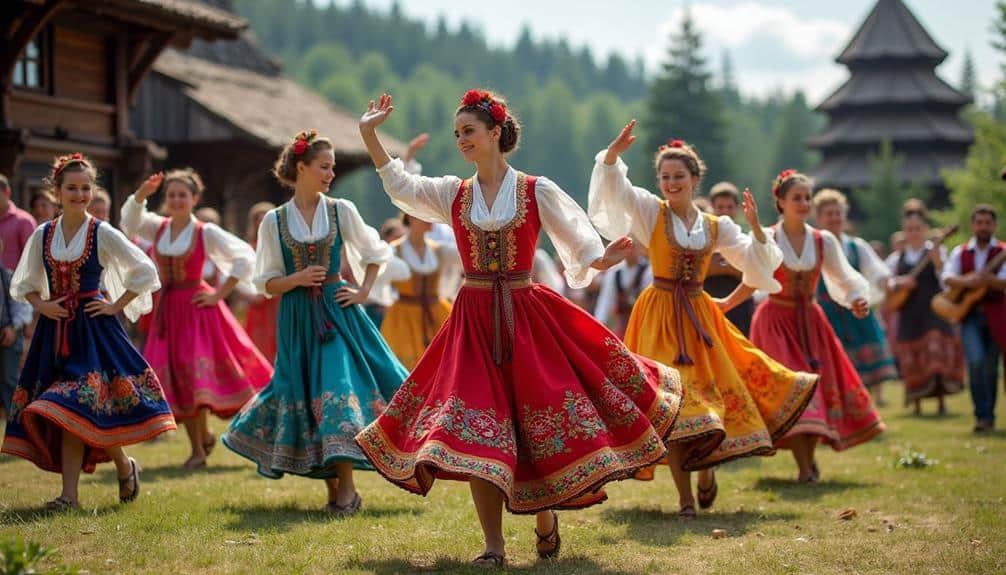
Russia’s vast and diverse geographical landscape has given rise to a rich array of regional dance variations, each reflecting the unique cultural and historical influences of its area. From the energetic dances of the Cossacks in the south to the graceful movements of the northern Pomors, these regional styles offer a fascinating glimpse into the country’s multifaceted heritage.
The dance costumes worn by performers are integral to these regional styles, often featuring elaborate embroidery, distinctive colors, and specific patterns that signify their place of origin. For instance, the traditional attire of the Cossack dancers usually includes vivid red and blue garments, symbolizing valor and loyalty.
In contrast, the northern Pomor dancers don heavier, fur-lined costumes suited to their colder climate, adorned with intricate geometric designs.
Furthermore, the choreography and music accompanying these dances also exhibit regional characteristics. Southern dances tend to be more vigorous and acrobatic, mirroring the lively spirit of the Cossack warriors, while northern dances are often more reserved and rhythmic, reflecting the serene nature of the Arctic environment.
These regional dance variations not only celebrate Russia’s cultural diversity but also preserve the historical narratives embedded in each dance form.
Influential Folk Musicians
A myriad of talented folk musicians has greatly shaped Russia’s musical landscape, leaving an indelible mark on both national and international stages. These influential artists have preserved and revitalized traditional songs, ensuring their cultural impact endures across generations.
One such luminary is Sergei Starostin, whose mastery of folk instruments and dedication to authentic performance has made him a cornerstone of Russian folk music. His work with folk ensembles like “Zhili-Byli” has brought ancient storytelling traditions to modern audiences.
Equally significant is Nadezhda Babkina, known for her powerful voice and dynamic performances. Leading the “Russian Song” ensemble, Babkina has showcased the richness of Russian folk music at numerous music festivals and dance festivals worldwide. Her efforts have not only popularized folk traditions but have also inspired a new generation of musicians.
Another notable figure is Dmitri Pokrovsky, whose innovative approach to folk music has expanded its reach. The Dmitri Pokrovsky Ensemble has explored the depths of Russia’s musical heritage, blending traditional and contemporary elements to create a unique soundscape.
These artists and their ensembles continue to shape the cultural fabric of Russia, ensuring that folk music remains a vibrant and essential part of its identity.
Modern Interpretations
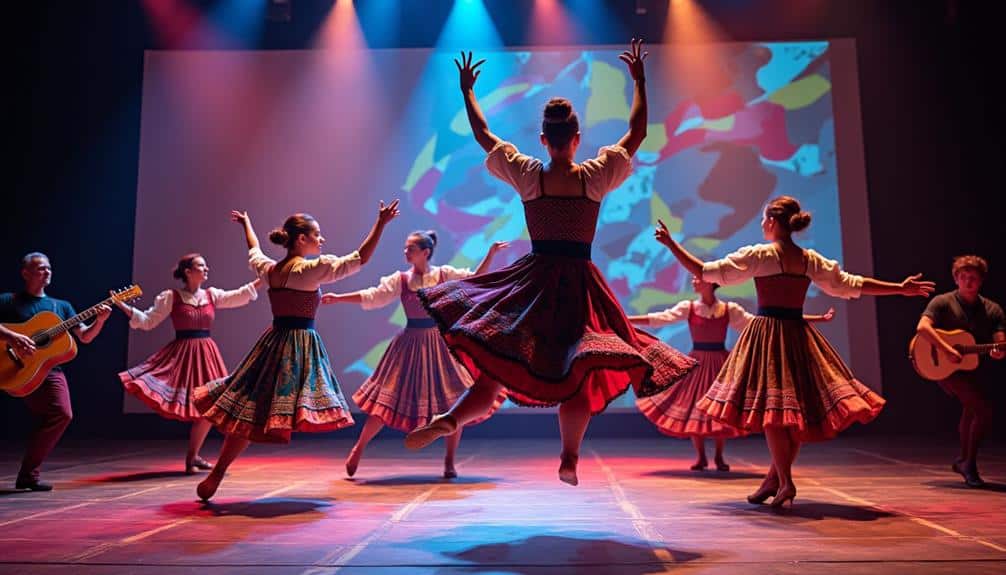
Building upon the foundation laid by influential folk musicians, modern interpretations of Russian folk dance and music have emerged, blending tradition with contemporary innovation. These new forms breathe fresh life into ancient practices while preserving their cultural essence.
Contemporary choreography, characterized by its inventive use of space and movement, is a significant aspect of these interpretations. Choreographers often integrate traditional steps with modern dance techniques, creating performances that resonate with both heritage and modernity.
Fusion performances are another hallmark of modern interpretations. These performances seamlessly merge folk elements with genres such as jazz, classical, and electronic music. The result is a rich tapestry of sound and movement that captivates diverse audiences.
For instance, ensembles might incorporate electronic beats into traditional melodies or pair folk instruments like the balalaika with electric guitars, creating a unique auditory experience.
These modern adaptations serve not only to entertain but also to engage a broader audience. They make Russian folk traditions accessible and relevant in today’s globalized world, ensuring their continued evolution and resonance.
Consequently, modern interpretations of Russian folk dance and music exemplify how cultural heritage can adapt and thrive in contemporary settings.
Cultural Significance Today
Amidst the rapidly changing landscape of global culture, the cultural significance of Russian folk dance and music today remains profound. These traditional forms serve as crucial expressions of cultural identity, offering a sense of continuity and belonging in an era marked by rapid modernization. For many communities, engaging in folk dance and music fosters community bonding, creating a shared experience that strengthens social ties.
Artistic expression in Russian folk traditions transcends mere performance; it encapsulates the historical and emotional narratives of the people. Generational transmission of these arts through families and educational programs guarantees that the heritage is preserved and adapted by newer generations. This continuous lineage not only safeguards the authenticity of the traditions but also enables them to evolve.
Social gatherings and festival celebrations often feature Russian folk dance and music, highlighting their role in communal life. Such events provide a platform for showcasing artistic skills and nurturing communal pride.
The global influence of Russian folk traditions can be observed in international festivals and cultural exchanges, where they contribute to a broader appreciation of diverse artistic heritages. Consequently, the enduring relevance of Russian folk dance and music underscores their indispensable role in both local and global cultural landscapes.




